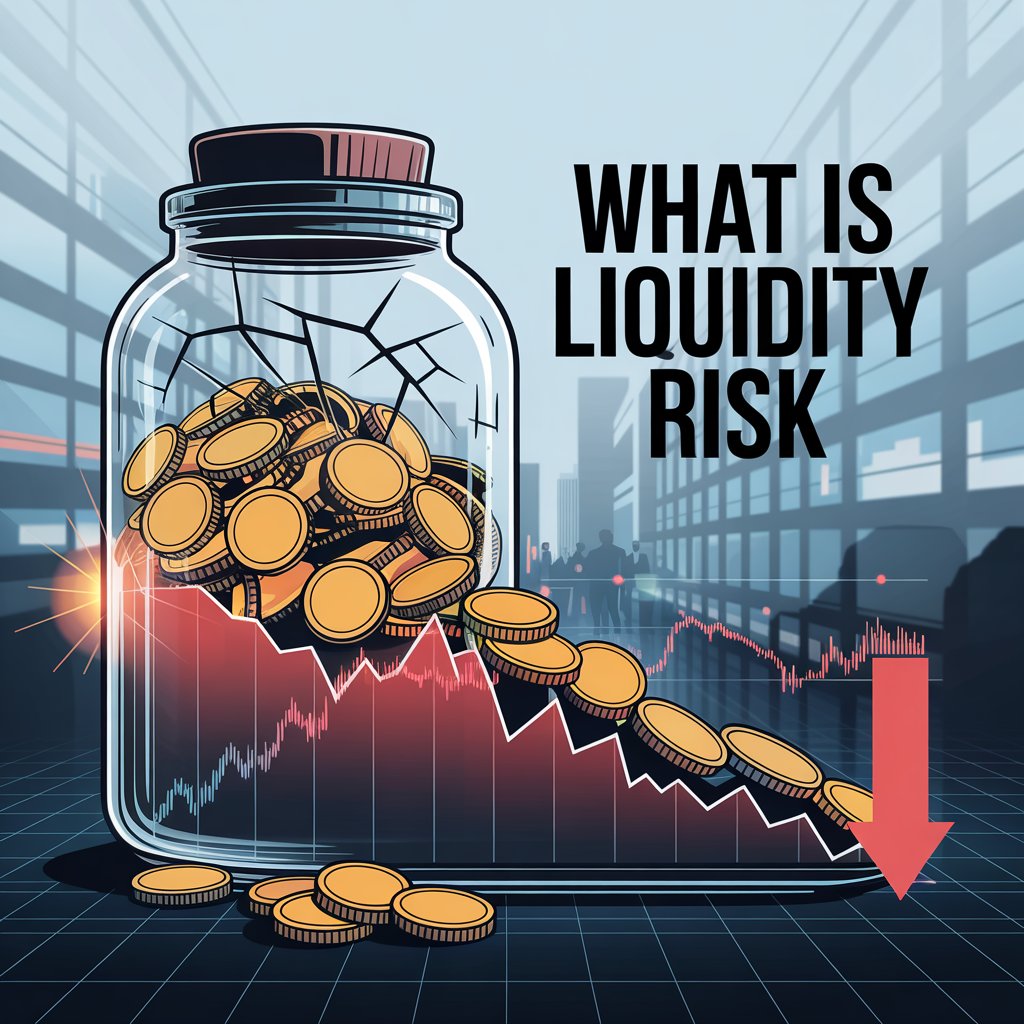The importance of liquidity in trading has become a vital criterion for investment decision-making for institutional and retail investors in the current, more volatile and interlinked economic environment. Liquidity was not long ago given much attention in financial modeling, however, the Global Financial Crisis that took place in 2007-2008 changed that perception. The prolonged Global Financial Crisis (GFC) period was a wake-up call, leaving no one behind, and one of the most important issues was liquidity. It was not just liquidity, but it was also a major driver of market risk. The outbreak of the financial crisis in the global economy was manifest and intensified by the drying up of trading and the steep fall in prices. Thus, the illiquid state of the assets was the real crisis.
This article outlines the turning points in which liquidity exposes the risk, distinguishes between different types of liquidity risks, and deciphers the false idea that high-volume markets are always liquid. Moreover, it is the mechanism of discovering and rebalancing the liquidity risk and how the knowledge of liquidity is the first step in the management of trading in the fast-paced, high-risk financial markets of today that is the article’s subject matter.
What Exactly Does Liquidity Mean?
Liquidity is the ease with which an asset can be exchanged for cash without a significant alteration of its price. The U.S. Treasury bonds, being a prime example of highly liquid assets, can be easily purchased or offloaded with very small price variance. On the other hand, illiquid investments such as commercial real estate or structured derivatives tend to remain in the market for a longer time, after which they are usually sold at a steep discount to attract buyers.
For the markets of today, liquidity makes trading efficient, reduces the costs of transactions, and stabilizes prices. Or in other words, the liquidity of an asset is the level of its ability to be easily liquidated under any conditions in the market, without affecting the price stability. In any case, the magnitude of available liquidity can affect trade outcomes, with losses arising from either slippage if one is still focused on long-term profitability or failure to exit a position. This basic principle underscores the huge impact of liquidity on trading.
Understanding “What Is Liquidity Risk?”
To know at what point liquidity starts to become a danger, it is necessary to answer the question “What Is Liquidity Risk?” Liquidity risk comes when an investor cannot quickly enough buy or sell an asset to avoid or lessen a loss. The reasons may be different, for example, a sudden drop in the interest of the buyers, legal restrictions, or the sharp volatility of the market.
There are two types of liquidity risk that we encounter:
- Funding Liquidity Risk: It describes a business’s ability to meet its short-term liabilities. A company may be profitable and still lack the money to pay if the assets are not easily converted into cash.
- Market Liquidity Risk: An investor is faced with this threat when it is almost impossible to get rid of a position without significantly moving the price of the asset. This issue becomes more critical in a crisis, when a seller shortage in the market affects even the previously easy-to-sell assets.
The liquidity risk that originates from both funding and market liquidity risks being present at the same time is the kind of risk that according to the GFC is particularly severe.
The Ghost of the Global Financial Crisis
In the period before the GFC, only a few models allowed for the emergence of liquidity risk. With the outbreak of the crisis, a new facet of liquidity was discovered, as it vanished in a day. In the short-term financial sector, the uncontrolled branch of banks, especially those providing risk through the collateralized repurchase (repo) markets, locked liquidity by raising the bar on collateral requirements.
Regarding this “run on the shadow banks,” the viral spread of the financial system was the ultimate consequence of a chain of occurrences where institutions would not be able to renew their short-term obligations or dispose of their long positions, thereby causing a downtrend in the prices of such assets. The realization that in moments of financial turmoil “risk and liquidity” are inseparable entities became obvious.
Funding Liquidity Risk: Can You Meet Your Obligations?
Funding liquidity risk is, at its base, a corporate finance issue. The relating to lack of cash or cashable assets to pay off immediate liabilities. Treasurers of companies often use metrics such as those given below to calculate this risk:
- Current Ratio = Current Assets / Current Liabilities
- Quick Ratio = (Current Assets – Inventory) / Current Liabilities
A cord of credit or acquiring short-term financing is possible ways to lessen the probability of such a risk. However, during the period when the financial markets were ceased—this occurred in 2008—these fall-back remedies still would be unsuccessful.
Furthermore, this provides the importance of still having the cash flow well managed and reserves kept, particularly in business with long cash cycles or high operational leverage.
Market Liquidity Risk: The Challenge of Exit
To answer market liquidity risk, it’s about the question of whether you can get out of a position without hitting the asset’s value. Consider the case: you have a property in a market that is falling. The property still has intrinsic value, but locating a buyer at that value might take too long, or be achieved by using a “fire-sale” price.
Among the different markets, such as U.S. Treasuries or S&P 500 stocks, small orders could be performed without much distraction. However, what if you had to handle large positions in small-cap stocks or happily hold those stocks with few alternatives? Only one large order can lead to a market move, and with it, the seller will have to bear the brunt of the losses.
This illustrates why the impact of liquidity on trading is so important – apart from the price direction, the main part of your profit can come from the place and moment of exiting a trade.
Key Drivers of Market Liquidity Risk
Several elements decide how liquid an asset is:
- Market Microstructure: The exchanges, such as NASDAQ, provide more liquidity than over-the-counter (OTC) platforms because they have centralized order books.
- Asset Complexity: Simple assets are more liquid. In the GFC era, complex derivatives such as collateralized debt obligations (CDOs) became virtually untradeable.
- Substitution Possibilities: If an asset can easily be replaced with another (like ETFs for stocks), it is usually more liquid.
- Time Horizon: Time availability is a benefit for sellers. Urgent sellers run the risk of lower liquidity.
All types of liquidity risk, including order execution risk, liquidation risk, and market risk, share one thing. They all get worse under time pressure.
Measuring Liquidity Risk: Bid-Ask Spread and Beyond
The simplest liquidity measure is certainly the bid-ask spread which is the difference between the price a buyer is ready to pay and what a seller is going to accept. If the spread is narrow, then it suggests that the liquidity is good.
Three aspects are used to measure the liquidity:
- Width: How small is the bid-ask spread?
- Depth: What transaction volume can be traded without changing the market price dramatically?
- Resiliency: How quickly can the market recover after a shock?
While the bid-ask spread portrays liquidity in forms of price, depth, and resilience tell us about volume and time taken by the market to react. Financial models that factor in spreads are referred to as exogenous liquidity models.
On the other hand, endogenous liquidity models concentrate on the balance of the order size versus the market capacity. It is the most crucial thing when the large institutions bust the trades.
Volume Isn’t Always a Sign of Safety
The thought of correlating high trading volume with good liquidity is alluring, but this notion can be misleading and dangerous. The Flash Crash of May 6, 2010, serves as an example where the trading volume shot up while the liquidity disappeared.
Algorithms with sell operations outperformed the system, as they forced the prices into a downward spiral. No orders were placed, the gap between the ask and bid price increased, and stocks of top-rated companies were traded at very low prices.
This incident broke the myth of volume, which implies liquidity, while reiterating the concept of “liquidity risks” being a possibility in a market led by algorithms.
Incorporating Liquidity into Risk Models
Liquidity-adjusted risk models are now an essential part of financial analysis. One popular technique is modifying Value-at-Risk (VaR) calculations to account for liquidity.
Let’s say you hold a $1,000,000 position with a daily volatility of 1%. Using standard VaR at 95% confidence (with a 1.65 deviation), the estimated daily loss is:
Standard VaR = $1,000,000 × 1% × 1.65 = $16,500
Now, assume a 4% bid-ask spread on the asset. To adjust for liquidity:
- Half the spread (2%) reflects exit cost.
- Add this to the standard VaR:
Liquidity-adjusted VaR = $1,000,000 × [1.65% + 2%] = $36,500
That’s more than double the original risk, underscoring why liquidity must be part of any serious risk assessment.
Treasury Bonds: A Safe Haven?
United States Treasury obligations are generally depicted as almost risk-free. This is not because they provide tremendous returns to the investors, but primarily because they offer almost perfect liquidity. These papers can be bought/sold in nearly any amount at current market prices. They are the instrument of low market risk, except in crises as they are backed by the government’s “full faith and credit”.
Still, no matter how low the risk is, a calamity can shake everything. For instance, situations like those would lead to a disruption of the Treasury markets, but this endanger is on a smaller scale in comparison to the other financial markets.
The Liquidity Conundrum of Alternative Assets
Diversification and possible earnings are the two appeals of the alternative assets (such as private equity, real estate, art, or collectibles). The main problem with these assets is their lack of liquidity, which is, most of the time, an inherent attribute of them.
It is these types of assets that are difficult to sell in a day and then only with a very low selling price. This illiquidity then is like building walls of ice around investors during downturns. So they are unable to move money or cover liabilities. This situation underlines how liquidity affects the performance of trading strategies when the assets are alternatives.
Global Liquidity and Systemic Risk
Due to the globalization of financial markets, the liquidity threat has become a global issue. The unity of global markets means that the shock in one place can turn into a storm in the whole world quickly.
To give an example, dollar assets with higher yields become more attractive to investors as the U.S. Federal Reserve starts tightening its monetary policy; thus, a credit shortage will happen in the market. This matter is termed “global liquidity,” and it shows the necessity of carefully monitoring not only domestic markets but also international funding flows.
Bid-Ask Spread: Human Behavior at Play
Essentially, the difference between the bid price and the ask price portrays human psychology. It is a reflection of the bargaining space between a buyer’s willingness and a seller’s demand. In times of fear or uncertainty, the spread gets significantly wider as buyers withdraw and sellers intensify by the moment.
This behavioral factor causes not only liquidity but also becomes a human factor in the commodity market. The primary thing is to know how people’s emotions, such as fear, greed, oruuncertainty influence the spread of crucial significance to determine the market sentiment.
The Final Word: Liquidity as a Double-Edged Sword
For one thing, liquidity is an open market—the trouble comes in when it is no longer so. Profits expand when liquidity is improving, transaction costs decrease, and market operations are assured to be efficient. Nonetheless, just like in the past, in times of liquidity shortage, the market is at a standstill, stock prices decline, and risks suddenly magnify.
Dealing with the issue of liquidity not only pertains to the trading aspect of a portfolio; it goes as far as being a fundamental aspect of portfolio management. The availability of ample market liquidity is a requirement regardless of whether one is a private investor buying ETFs or a manager handling large institutional portfolios. It becomes obligatory to include liquidity measures in your risk framework, as it is not only recommended, but it is also a must.
During normal periods, liquidity risk is not easily distinguishable. Nonetheless, when the situation becomes strained, liquidity trumps all other risks. This is a key element in efficient investing and hence the primary reason why liquidity is viewed as a mysterious force in today’s financial world. After all, the impact of liquidity on trade is not only confined to the ways or the conditions under which one can gradually step out of the market, but is also inclusive of other factors.




